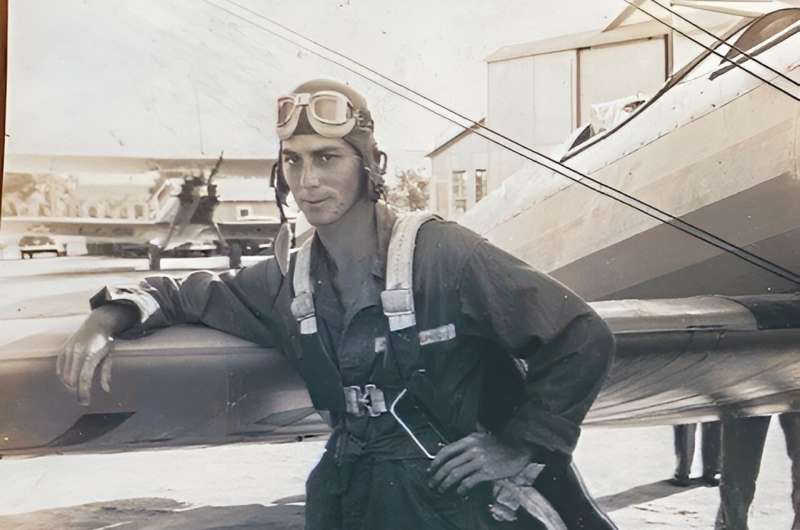Forensic Experts Aid in Locating Missing WWII Pilot after 80 Years

The date is November 16, 2023
This piece has undergone a thorough review as per the editorial process and policies of Science X. The editors have paid special attention to ensure the credibility of the content, taking note of:
- fact-checking
- sourcing credibility
- proofreading
by Cranfield University
The story begins on a certain summer day in July 1943. Coming from Tunisia in North Africa, a U.S. B-25 Mitchell bomber with a mission to attack the Sciacca Aerodrome in Sicily, Italy, was in flight.
Of the six crew members aboard, one was 27-year-old US Army Air Forces (USAAF) 2nd Lt Gilbert Haldeen Myers. The co-pilot, from Pittsburgh, Pennsylvania, was part of the 381st Bombardment Squadron, 310th Bombardment Group.
As the plane neared its target, however, it was hit by anti-aircraft fire. Consequently, it lost altitude and crashed some one and a half miles away from the aerodrome.
Reports after the accident noted a crew member escaping the bombing vehicle before its crash, but Myers was not found. He was then marked as missing in action after no survivors or prisoner records were found. It’s estimated that of the 72,000 American personnel from World War II who remain unaccounted for, 39,000 can still be recovered. Despite search and rescue attempts near Sciacca in 1947, Myers remained one of these individuals with no clues available pointing back to him.
All that changed nearly 80 years after the B-25 crash, however. The Recovery and Identification of Conflict Casualties team from Cranfield University, in collaboration with the US Defense Prisoner of War/Missing in Action Accounting Agency (DPAA), went to Sciacca to conduct a thorough investigation. In October 2023, the team confirmed that they discovered human remains that belonged to Myers, proving it through DNA testing in the U.S.
The Cranfield team had a 20-member task force whose mission was to examine the surrounding areas of the impact location. They painstakingly worked through tons of soil in the hopes of finding either human remains or personal belongings that could aid in identifying crew members.
According to Dr. David Errickson, Senior Lecturer in Archaeology and Anthropology at Cranfield Forensic Institute, the processes were difficult. To affect their analyses, they had to use wet screening for objects found. One example of such a challenging environment was the excavation site in Sicily. He added that his forensic team has also been part of several aircraft crash probes, including the forthcoming mission to a Boeing B-17 recovery site.
The meaning of their work goes beyond the recovery of the remains. It allows a respectable military burial and any personal items found can be given to the family. It also provides closure to families of those missing or killed in action.
After being examined and identified at the DPAA Laboratory, the remains were confirmed as Myers’s on August 10. The laboratory also discovered parts of the plane wreckage.
Similar to the Cranfield team, the DPAA used DNA tests, anthropological evidence, and circumstantial evidence for identification. Myers’ name will be added, together with others still missing, to the Walls of the Missing at Sicily-Rome American Cemetery in Nettuno, Italy. They are now planning to add a rosette beside his name to signify that he has now been accounted for.
Before Remembrance Day this year, Myers was laid to rest in St. Petersburg, Florida, on November 10.
Dr. Nicholas Márquez-Grant, a Forensic Anthropologist at Cranfield Forensic Institute, said that there are times that this kind of excavation can leave questions unanswered. Certain factors, like changes in the terrain or land use post-incident, can influence the findings. Small bits of evidence can sometimes be all that is found, but these can be crucial in identifying an individual.
'In this case, playing a role in the quest to locate a missing serviceman was a profound privilege, bringing closure to Gilbert Haldeen Myers' family.'
The team from Cranfield University included graduates of the Forensic MSc program.
Specialists from Cranfield Forensic Institute (CFI) also assisted with the recovery and identification earlier this year of U.S. Army Air Forces Staff Sgt. Edgar L. Mills, who was killed in action over Germany during the Second World War. This is part of Cranfield University's continued dedication to recover the missing who have died in conflicts.
Provided by Cranfield University




